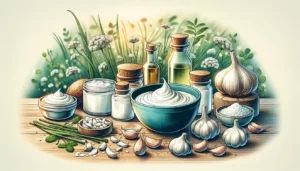10 Safe & Effective Home Remedies for Earaches: Natural Relief for All Ages (2025 Guide)
Estimated reading time: 9 minutes
- Earaches have varied causes, but most respond well to natural remedies if used safely and early.
- Apply home methods like warm compresses, olive oil, or hydration, but watch for warning signs needing medical care.
- Garlic oil and hydrogen peroxide offer targeted solutions for minor infections and wax buildup.
- Children require extra caution; always consult a healthcare provider for suspicious symptoms.
- Never poke inside the ear or use undiluted essential oils; these increase risks and pain.
- Professional help is crucial for persistent pain, high fever, or fluid drainage.
- Prevent future earaches by practicing gentle ear care, proper hydration, and early intervention with colds or congestion.
- Introduction to Earache Relief at Home
- Understanding Earaches: Causes and Symptoms
- Safety First: Precautions Before Trying Home Remedies
- Top 10 Home Remedies for Earache Relief in 2025
- Special Considerations: Earache Remedies for Children vs. Adults
- What Not to Do: Common Mistakes to Avoid
- When Home Remedies Don’t Work: Next Steps for Earache Care
- Frequently Asked Questions (FAQs) on Earache Remedies
Introduction to Earache Relief at Home
Earaches can strike without warning, leaving you or your loved ones in discomfort, searching for quick relief. At WikiHomeRemedies, we understand how distressing this pain can be, whether it’s a child struggling to sleep or an adult facing throbbing discomfort. That’s why we’ve crafted this 2025 guide to bring you safe, natural home remedies that work for all ages, helping you find comfort right from your kitchen or medicine cabinet.
Our goal is to ease your worry with practical solutions grounded in science, drawing from trusted sources like the National Institutes of Health (NIH) and the World Health Organization (WHO). Earaches are common—studies from the NIH show millions experience them yearly, especially children—but they don’t always need a doctor’s visit right away. We’ll explore remedies, share safety tips, and highlight when to seek professional care.
Remember, this information serves as a guide, not medical advice. If symptoms worsen or persist, consult a healthcare provider to ensure proper treatment. Let’s dive into understanding earaches better and discover how nature’s healing power can help.
Understanding Earaches: Causes and Symptoms
When an earache hits, it’s often a sharp reminder of how much we rely on our hearing and balance. This pain can stem from various parts of the ear—outer, middle, or inner—and knowing the source helps in choosing the right care. Whether it’s a nagging ache or a sudden sting, earaches often signal an underlying issue that needs attention.
Many factors can trigger this discomfort. Infections in the middle ear, known as otitis media, top the list, especially in children, according to the Mayo Clinic. Other culprits include earwax buildup, sinus pressure pushing on ear canals, swimmer’s ear from trapped moisture, or even injuries from loud noises or trauma. Each cause carries its own set of challenges, but home remedies can often soothe the pain when used wisely.
Symptoms vary but typically include a persistent ache, trouble hearing, or fluid leaking from the ear. You might notice fever, dizziness, or irritability, particularly in young ones who can’t yet explain their pain. The Centers for Disease Control and Prevention (CDC) note that these signs often point to how severe the issue might be. Recognizing them early helps you decide whether to try a natural solution or head to a doctor.
Common Causes of Earaches
- Middle ear infections, frequent in children due to shorter Eustachian tubes, as per the American Academy of Pediatrics (AAP).
- Earwax buildup, which can block the canal and cause pressure or pain.
- Sinus infections, pushing congestion into ear pathways.
- Swimmer’s ear, an outer ear infection often linked to water exposure.
- Injuries, sometimes from loud sounds or physical impact to the ear area.
Symptoms to Watch For
- Persistent or sharp pain in one or both ears.
- Fever, often a sign of infection, especially above 100.4°F (38°C) per CDC guidelines.
- Hearing challenges or a muffled sensation.
- Fluid drainage, which could indicate a rupture or infection.
- Dizziness or balance issues, hinting at inner ear involvement.
Safety First: Precautions Before Trying Home Remedies
Before reaching for a natural fix, take a moment to ensure it’s the right move for you or your family. Earaches might seem straightforward, but underlying conditions like a perforated eardrum or a severe infection can turn a well-meaning remedy into a problem. At WikiHomeRemedies, we prioritize your well-being, so let’s cover the ground rules to keep things safe.
Not every remedy fits every situation. If you’re dealing with a young child, someone with ongoing health issues, or a pregnant individual, extra care is needed—some solutions could do more harm than good. The CDC advises watching for warning signs that demand a doctor’s input. Trust your instincts; if something feels off, pause and seek guidance.
Here are key red flags to note:
- Pain lasting over 48 hours without improvement.
- High fever, especially in children, above 102°F (39°C).
- Sudden dizziness or loss of balance, which could signal deeper issues.
- Visible swelling or redness around the ear, per Mayo Clinic warnings.
- Any sign of fluid or pus draining from the ear.
Grounded in trustworthy guidelines from sources like the CDC, these precautions aim to protect you. Home remedies can work wonders, but only when applied with caution. Let’s move forward with confidence, knowing safety comes first.
Top 10 Home Remedies for Earache Relief in 2025
When ear pain disrupts your day, relief can often be found in simple, natural methods waiting at home. We’ve gathered ten trusted remedies to help soothe discomfort for all ages, each backed by practical wisdom and scientific insights from places like PubMed and the NIH. Follow these steps carefully, keeping safety in mind, and let nature lend a hand in easing your pain.
Warm or Cold Compress
A warm or cold compress offers a gentle way to calm ear pain by tackling inflammation. Heat boosts blood flow to relax tense areas, while cold numbs sharp aches—choose based on what feels best. The Cleveland Clinic supports this method as a safe starting point for most.
Here’s how to do it:
- Soak a clean cloth in warm water (not hot) or wrap an ice pack in a towel.
- Place it against the affected ear for 10-15 minutes.
- Repeat every few hours, ensuring it’s comfortable, especially for kids.
Keep it safe by avoiding direct heat or ice on skin—always use a barrier. This works well across ages when done with care.
Garlic Oil Drops
Garlic has long been valued for its ability to fight microbes, making it a potent ally against ear infections. Studies on PubMed highlight its natural properties that may reduce pain-causing bacteria. Garlic oil, when prepared properly, can bring relief right where it’s needed.
Try this approach:
- Crush a fresh garlic clove and mix with a tablespoon of olive oil.
- Warm slightly (test on your wrist to avoid burns), then strain.
- Use a dropper to place 2-3 drops in the affected ear, tilting your head for 5 minutes.
Never use if there’s a chance of a ruptured eardrum—check with a doctor if unsure. A pre-made garlic oil option can simplify this step for convenience. Visit Home Remedies for an Ear Infection for more details about garlic oil’s benefits and preparation.
Olive Oil
Olive oil can soften earwax, a common pain trigger, helping it ease out naturally without harsh poking. It’s a simple, safe choice when there’s no sign of infection or damage. Many have turned to this kitchen staple for generations with good results.
Follow these steps:
- Warm a teaspoon of pure olive oil to body temperature.
- Lie on your side and drip 2-3 drops into the ear.
- Stay still for 5-10 minutes before wiping away excess with a cloth.
Ensure the oil isn’t too hot and stop if discomfort increases. This remedy suits mild cases best.
Hydrogen Peroxide
For ears clogged with wax, hydrogen peroxide can bubble away debris, relieving pressure. It’s a common household item, but dilution matters to prevent irritation. Use it only for wax buildup, not infections.
Here’s the method:
- Mix equal parts 3% hydrogen peroxide and water.
- Tilt your head and drip 5-10 drops into the ear using a dropper.
- Wait 5 minutes as it fizzes, then tilt to drain onto a towel.
Avoid if there’s pain suggesting infection or damage. Rinse with warm water afterward if needed.
Chewing Gum or Yawning
Sometimes ear pain ties to pressure in the Eustachian tubes, often from colds or altitude changes. Chewing gum or yawning opens these passages, easing the strain. It’s a subtle trick with no supplies needed.
Simply do this:
- Chew sugar-free gum for 10-15 minutes to activate jaw movement.
- Alternatively, yawn widely a few times to shift inner ear pressure.
This suits mild discomfort, especially post-flight or during congestion. It’s safe for most but won’t address infections.
Salt Sock Compress
A warm salt sock brings soothing heat to the ear, much like a compress, helping with pain and swelling. The salt retains warmth longer, offering steady relief. It’s a cozy, old-fashioned fix.
Make one like this:
- Fill a clean sock with 1-2 cups of coarse sea salt and tie it shut.
- Heat in a pan or microwave until warm, not hot.
- Place over the ear for 10-20 minutes, reheating as needed.
Test the temperature first to prevent burns. This is gentle enough for children with supervision.
Basil Oil
Basil carries natural compounds that might calm inflammation and fight minor infections. A few drops mixed with a carrier oil can target ear discomfort directly. It’s lesser-known but promising for mild cases.
Prepare it this way:
- Crush fresh basil leaves and mix with a teaspoon of coconut oil.
- Warm slightly, strain, and apply 2-3 drops into the ear.
- Rest for 5 minutes, keeping your head tilted.
Use cautiously and avoid if allergic to basil. Always ensure no deeper issues exist before trying.
Elevated Sleeping
Sleeping with your head raised can drain fluids from the ear, cutting down on pressure overnight. It’s a passive way to support recovery, especially during colds. No tools are needed—just a pillow adjustment.
Set up like this:
- Stack an extra pillow or two under your head while lying down.
- Keep the affected ear facing up to aid drainage.
- Maintain this position through the night if possible.
This helps alongside other remedies. It’s safe for everyone but watch for neck strain.
Hydration and Rest
Staying hydrated thins mucus that can clog ear tubes, while rest lets your body fight off infections. It’s a foundational step often overlooked. Support your system naturally with this focus. For more natural ways to boost your immunity during infections, see Home Remedies for a Sore Throat, which shares hydration and rest tips applicable here.
Keep it simple:
- Drink water regularly, aiming for 8-10 glasses daily (2-2.5 liters).
- Rest in a quiet, comfortable space to reduce stress on your body.
This boosts other remedies’ effects. It’s vital during any illness tied to ear pain.
OTC Pain Relievers
Over-the-counter options like ibuprofen or acetaminophen can dull ear pain while you address the cause. They’re not a cure but offer temporary ease. Always check dosing, especially for children.
Use them safely:
- Follow package instructions for age and weight-specific doses.
- Take with food to protect your stomach lining.
- Limit use to a day or two unless a doctor advises otherwise.
Pair with natural methods for best results. Consult a healthcare provider if pain persists.
Special Considerations: Earache Remedies for Children vs. Adults
Earaches don’t affect everyone the same way, and tailoring care to age makes a big difference. Children and adults face unique risks and causes, so let’s break down how to approach relief for each group. At WikiHomeRemedies, we want you equipped with the right knowledge for your loved ones.
Children and Earaches
Younger ears are more vulnerable due to narrower Eustachian tubes that trap fluids easily, per the AAP. Infections strike often—over 80% of kids face one by age three. Stick to gentle options and watch closely.
- Warm compresses soothe without risk; keep heat mild.
- Elevated sleeping helps drain fluids overnight safely.
- Avoid drops or oils unless a pediatrician clears it.
- Monitor fever—above 102°F (39°C) needs urgent care.
- Irritability or tugging at ears signals pain; don’t delay help.
Always prioritize a doctor’s input for kids under two. Their small systems need extra caution.
Adults and Earaches
Grown-ups often deal with earaches from swimmer’s ear or jaw tension rather than middle ear issues, notes the NIH. Causes differ, so remedies can too. Focus on what matches your trigger.
- Cold compresses work for swimmer’s ear inflammation.
- Chewing gum helps if jaw or pressure is the culprit.
- Hydrogen peroxide suits wax buildup, common in adults.
- OTC relievers manage pain during longer waits for care.
Adults can often self-assess better but shouldn’t ignore severe signs. Persistent issues mean it’s time for a professional look.
What Not to Do: Common Mistakes to Avoid
While seeking relief, it’s easy to stumble into habits that worsen ear pain. At WikiHomeRemedies, we’ve seen misguided steps cause delays in healing, so let’s steer clear of pitfalls. Knowing what to avoid is just as powerful as knowing what to try.
Poking inside the ear with cotton swabs or objects tops the list of errors. The Mayo Clinic warns this pushes wax deeper or risks injury to delicate tissues. Similarly, using undiluted essential oils can irritate the canal—always mix with a carrier like olive oil if you must. Old myths, like blowing smoke into the ear for relief, lack any evidence and may expose you to toxins.
Resist the urge to ignore worsening pain or fever, hoping it’ll pass. Delaying care for clear red flags can lead to complications. Stay informed with credible guidance, and don’t let desperation drive risky choices. Your ears deserve thoughtful protection.
When Home Remedies Don’t Work: Next Steps for Earache Care
Sometimes, despite your best efforts, home remedies fall short, and that’s okay. Ear pain lingering beyond a couple of days or paired with troubling signs means it’s time to step up care. At WikiHomeRemedies, we’re here to guide you on what comes next with clarity.
If you face relentless pain, fever spiking past 102°F (39°C), dizziness, or fluid draining from the ear, a doctor’s visit is non-negotiable. The WHO emphasizes that untreated infections can deepen, risking hearing issues. A healthcare provider might diagnose an infection needing antibiotics or spot a structural concern requiring specific treatment.
Prevention also plays a role moving forward. Keep ears dry after swimming, avoid over-cleaning with swabs, and manage colds early to stop sinus spread, as NIH suggests. These small habits cut down on repeat aches. Trust your gut—if relief isn’t coming, professional help ensures you’re on the right path.
See more on preventing ear infections and repeat aches in Home Remedies for an Ear Infection.
Supplemental Content: Frequently Asked Questions (FAQs) on Earache Remedies
We know earaches spark plenty of questions, so let’s tackle some common ones to round out your understanding. Drawing from trusted insights, these answers aim to clear up doubts and support your journey to relief.
Are ear drops safe for children?
Not always. Drops, even natural ones like garlic oil, can harm if there’s an unseen rupture or infection, per AAP guidance. Always check with a pediatrician before using them on kids under five to stay safe.
What’s the difference between an earache and an ear infection?
An earache is the pain itself, felt in or around the ear, while an infection, often otitis media, is a specific cause involving bacteria or viruses. Pain can come from other issues like wax or injury too.
Which remedies are best for wax buildup versus infection?
Hydrogen peroxide or olive oil helps soften wax for removal, while infections might need warmth from compresses or garlic oil for antimicrobial support. Match the remedy to the root issue.
How do warm and cold compresses differ in effectiveness?
Warmth eases muscle tension and boosts circulation, great for infection pain, while cold numbs sharp aches and cuts swelling, ideal for injuries. Test both to see what soothes best.










